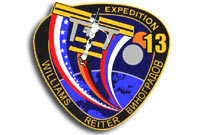NASA International Space Station Status Report 25 August 2006

With the countdown clock ticking toward the launch of Space Shuttle Atlantis on the STS-115 mission, the International Space Station crew continues to prepare for visitors.
Commander Pavel Vinogradov, Flight Engineer, NASA Science Officer Jeff Williams and European Space Agency astronaut Thomas Reiter of Germany are ready for Atlantis to deliver a new section of the station’s girder-like truss. Atlantis is set for launch on Sunday, which would result in docking with the station on Tuesday. During Atlantis’ mission, astronauts will attach the new P3/P4 truss, a segment that includes a huge new set of solar arrays and a giant rotary joint to allow them to track the sun.
To prepare for Atlantis’ visit, the station crew members packed items that will be returned to Earth on the shuttle. They also reviewed spacewalk plans, talked with the shuttle crew in a long-distance conference and trained to photograph the shuttle’s heat shield as Atlantis does a backflip while approaching the station.
Flight controllers tested the operation of a U.S. air scrubbing system in advance. The Carbon Dioxide Removal Assembly, or CDRA, was turned on for an extended period to test its capability to remove carbon dioxide from the air. The CDRA augments the Russian air scrubber, Vozdukh, which was turned off during the test. Engineers are continuing to evaluate data from the CDRA operations.
The station was raised 2.5 miles by firing the ISS Progress 21 engines Wednesday. The boost places the complex at the optimum position for Atlantis’ rendezvous and docking. It also puts the station at the optimum altitude for the launch of the next station resident crew, Expedition 14, from Kazakhstan in September.
Williams replaced filters in part of the station’s cooling system. The used filters will be returned to Earth for engineering analysis to confirm their success at removing fine particles from water in coolant lines.
Williams completed runs of the Dust and Aerosol Measurement Feasibility Test, or DAFT experiment. DAFT is testing the effectiveness of a commercial hand-held air quality monitor called P-Trak that counts ultra-fine dust particles in microgravity. The study provides data that may help in the design of fire detection systems on future spacecraft. Its data also may prove useful for fire detection hardware in extreme environments on Earth, such as submarines or underwater laboratories.
The station crew continued with the set-up and check-out of the European Modular Cultivation System (EMCS) that was delivered on STS-121. This experiment system contains a centrifuge that can subject a wide range of small plant and animal experiments to partial gravity conditions.
The first experiment that will be performed in EMCS is the Analysis of a Novel Sensory Mechanism in Root Phototropism, called Tropi, which seeks to identify the genes responsible for successful plant growth in microgravity. The experiment studies mustard seeds.
Vinogradov and Reiter participated in European Space Agency science experiments that test the cardiovascular system’s response to microgravity for long durations.
The next station status report will be issued after the STS-115 shuttle mission. The status of the ISS will be included in the twice-daily shuttle mission status reports issued during STS-115. For more about the crew’s activities and station sighting opportunities, visit:








